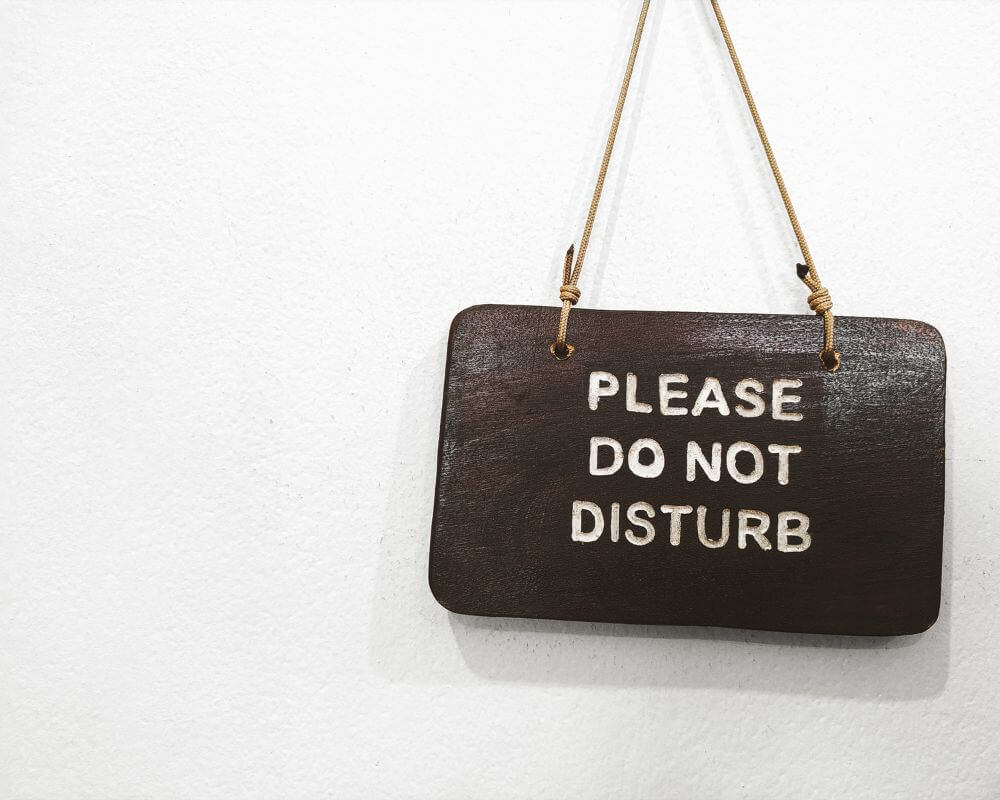Are you tired of constantly getting text messages from someone who won’t take a hint?
Do you want to know how to get someone to stop texting you?
Don’t worry, we’ve got you covered. We’ve put together a list of 30 effective ways to get someone to stop texting you.
Whether you want to be subtle or direct, we’ve got options for you. Keep reading to find the perfect solution for your situation.
How To Get Someone To Stop Texting You
Are you tired of constant text messages from someone who won’t take a hint?
Receiving unwanted texts from someone can be a nuisance and can cause distress. If you find yourself in this situation and want to get the person to stop texting you, there are several steps you can take.
With 30 effective ways to stop someone from texting you, you’ll be able to find the perfect solution for your situation.
From subtle to direct methods, we’ve got options for every situation. Keep reading to finally put an end to those unwanted texts.
In this guide, we will go over some practicals for getting someone to stop texting you.
#1: Set clear boundaries
Communicating to the person that you do not want to receive more texts from them is an essential step in setting clear boundaries.
It means that you are clearly and directly expressing your wishes to the person. You are letting them know that their texting behavior is not acceptable to you.
There are different ways to do this, such as having a face-to-face conversation, making a phone call, or sending a text message.
The most important thing is to be clear and direct in your communication and avoid being vague or ambiguous.
When you set clear boundaries, you are taking control of the situation and making it clear what behavior is unacceptable to the person.
#2: Use assertive language
Being direct and firm when asking someone to stop texting sends a clear message that you are serious about your boundaries and expect the person to respect them.
It is vital to use assertive language, as it shows the person that you are confident and strong in expressing your desires and that you are not afraid of standing up for yourself.
Using phrases such as “I do not want to receive any more texts from you” is a clear and firm way to communicate your boundaries to the person. “I need you to stop texting me” is another way to clearly and firmly communicate your boundaries.
It shows that you are unwilling to accept their behavior and expect them to respect your wishes. It also sends a message that you will not accept any more unwanted messages, and they need to stop.
#3: Utilize technology
Blocking the person’s number or using a call-blocking app to limit contact is an effective way to stop unwanted texts. It prevents the person from reaching you.
Blocking the person’s number is essentially cutting off their ability to contact you. It can be a powerful message that you are serious about your boundaries and unwilling to accept unwanted texts.
Using a call-blocking app is also a great option. It allows you to block unwanted numbers. It also provides various other features, such as identifying unknown numbers.
Creating a list of blocked numbers and even blocking calls and messages from specific contacts are some of the other features provided.
This can be particularly useful if you receive unwanted texts from multiple numbers or want more control over who can reach you.
#4: Be consistent
Being consistent when setting boundaries is crucial to communicate them to the person who is texting you effectively. When you set boundaries, it’s essential to follow through on them and not respond to other texts from the person.
This conveys that you are serious about your boundaries and expect the person to respect them. When you respond to their texts, it sends mixed signals. It makes it more difficult for the person to understand your boundaries. They may continue to text you, or even increase the frequency of their texts.
Consistency is important because it shows the person that you are serious about your boundaries and expect them to be respected. Responding to their texts can give them the impression that it’s okay to continue texting you or that you are not serious about your boundaries.
#5: Be respectful

Being respectful when communicating your boundaries is crucial in ensuring that the person you are communicating with understands and respects your wishes. It’s important to avoid being aggressive or confrontational. It can cause the person to become defensive or argumentative, making it less likely that they will understand and respect your boundaries.
When communicating your boundaries, a calm and respectful tone helps diffuse the situation and makes it more likely that the person will understand and respect your wishes.
Using a calm and respectful tone shows the person that you are not trying to attack them or blame them for the situation. Instead, you are simply communicating your boundaries and expecting them to be respected.
#6: Keep it simple
Don’t over-explain or justify your decision to the person. The less you say, the more effective it will be in stopping unwanted texts.
Keeping it simple is an effective way to communicate your boundaries to someone texting you. Avoid over-explaining or justifying your decision to the person; keep your communication simple and to the point.
It can help ensure that the person understands your boundaries. Respects your wishes and can make it more effective in stopping unwanted texts.
#7: Be honest
It’s essential, to be honest and tell the person why you want them to stop texting you. They may not be aware that their texts are unwanted.
By telling them the reason, you allow them to understand your perspective and to change their behavior.
For example, if you feel overwhelmed by the number of texts you receive. It’s important to be honest and tell the person that it is causing you stress and that you need them to stop texting you.
#8: Use humor

Using humor can effectively diffuse the situation and make it clear that you are not interested in receiving more texts. Humor can be a great tool to convey your message in a non-confrontational and non-threatening way.
Using light-hearted jokes or humor can help to lighten the mood and make it clear that you are not taking the situation too seriously. By doing this, you can communicate your boundaries to the person in a less direct and less confrontational way.
For example, you could respond to an unwanted text with a joke or a witty comment. Making it clear that you are not interested in receiving any more texts without being aggressive.
#9: Change your number
Changing your phone number can be an effective way to get someone to stop texting you if all other methods have failed. However, it should be considered a last resort. It may have negative consequences if the person is someone you care about, or you rely on them for important information.
Changing your phone number can be a drastic measure. Still, it can be a good solution if the person repeatedly texts you even after you have communicated your boundaries and asked them to stop.
It will effectively stop them from being able to contact you, as they will no longer have your number. However, it is essential to remember that it will also make it difficult for them to contact you in an emergency. Or if they need to get in touch with you for important information.
#10: Don’t respond
Ignoring the messages and not responding is one of the best ways to get someone to stop texting you. It is a simple yet effective method that can help you stop unwanted texts without engaging in a confrontation or argument.
When someone texts you and you do not respond, you show the person that their texts are not getting the desired reaction. They will likely stop texting you if you are not responding to their messages. This is because people often text others to get a positive or negative reaction; if they do not, they will likely stop messaging.
#11: Be polite
Being polite is important to ensure that the person you are communicating with understands and respects your wishes. While also preventing the situation from escalating. Using polite and courteous language instead of being rude or aggressive. It can make the person more likely to understand and respect your boundaries.
When communicating your boundaries, it’s important to use polite language such as “please” and “thank you” to convey your message respectfully.
It can show the person that you are making a request, not a demand, and that you are trying to find a solution that works for both parties.
#12: Use the “do not disturb” feature

Using the “Do Not Disturb” feature on your phone can effectively stop unwanted texts from someone.
The “Do Not Disturb” feature allows you to silence calls, notifications, and texts or schedule times to enable and disable the feature automatically. It can be helpful if you receive unwanted texts at specific times, such as during work hours or while sleeping.
When you enable the “Do Not Disturb” feature, you will not receive any notifications or alerts for calls, texts, or other notifications. It can be helpful if you receive unwanted texts from someone and don’t want to be bothered by the messages.
#13: Be persistent
Being persistent in communicating your boundaries is important when trying to get someone to stop texting you. It may take time for the person to understand and respect your boundaries. It’s essential to be persistent and not give up if they continue to text you.
It’s essential to be consistent and follow through on your requests. Be patient if the person does not stop texting you right away.
Being persistent also means maintaining a polite and respectful tone when communicating your boundaries.
#14: Use a “text-blocking” app
Using a “text-blocking” app can be an effective way to stop unwanted texts from someone. Many apps, such as Call Blocker or Mr. Number, can block unwanted texts.
These apps can be useful tools to help you manage unwanted texts and provide an additional layer of protection.
Text-blocking apps allow you to add specific numbers to a block list. Once a number is added to the list, the app will prevent texts from that number from coming through. Some apps also provide additional features such as call blocking and spam filtering.
#15: Use social media

Blocking someone on social media prevents them from seeing your profile or sending you any messages. It can be an effective way to stop someone from texting you if they are doing so through social media.
Additionally, unfollowing someone on social media will prevent you from seeing their posts and stop them from appearing on your timeline.
It’s important to note that there may be better solutions than blocking or unfollowing someone on social media. Especially if the person is, someone you care about or an urgent matter needs to be addressed.
#16: Be clear
Clear and concise communication can prevent confusion and ensure that the person understands your boundaries. When communicating your limits, it’s essential to be clear and specific about what you want and what you don’t want.
Avoiding being vague or ambiguous can make it more likely that the person will understand and respect your boundaries.
For example, instead of saying, “I don’t want to talk to you anymore,” you can say, “I would like you to stop texting me.” It is a more precise statement that communicates your boundaries directly and concisely.
#17: Use a “text-free” number
Consider getting a “text-free” number that you can use for important contacts, such as family and friends. It can limit unwanted texts and make it easier to manage your contacts.
Using a “text-free” number can be a helpful way to limit unwanted texts and make it easier to manage your contacts. A text-free number is a phone number that does not have texting capabilities and can only be used for calls.
Using a text-free number for important contacts such as family and friends can help limit unwanted texts.
#18: Take a break
Taking a break can be useful when trying to get someone to stop texting you. Especially if the person is someone you care about. It can give you time to consider what you want from the relationship and if it’s worth continuing.
Setting boundaries cannot be easy when someone you care about is texting you too much. Taking a break can help you to step back from the situation and clear your mind.
It also gives you time to reflect on what you want from the relationship and if it’s worth continuing.
#19: Use the “mute” feature
The “mute” feature can effectively block incoming messages and limit contact if the person is texting you through a messaging app.
Many messaging apps, such as WhatsApp and Facebook messenger, have built-in “mute” features that allow you to block incoming messages without blocking the person’s number or unfollowing them on social media.
The “mute” feature allows you to silence notifications for specific chats or groups, so you will no longer receive notifications when the person messages you.
It can effectively limit contact without blocking the person’s number. This is helpful if you still want to keep in touch with the person but need to limit the frequency of their messages.
#20: Use the “spam” feature

When you mark a conversation as spam, the messaging app will automatically move the conversation to a spam folder, so you will no longer receive notifications when the person messages you.
It can help to filter out unwanted messages and make it easier to manage your contacts. It can also help prevent the person’s messages from cluttering your inbox, making it easier to focus on important messages.
It’s important to note that marking a conversation as spam may not block the person from messaging you again. It’s a way to filter messages from that contact and not a way of blocking them.
#21: Use the “block” feature
The “block” feature can effectively stop unwanted or harassing messages if the person is texting you through a messaging app.
Many messaging apps, such as WhatsApp and Facebook messenger, have built-in “block” features. These features allow you to block specific contacts, preventing them from messaging you.
It can help to ensure that their messages are flagged and that appropriate action is taken.
When you block a contact, the messaging app automatically prevents the person from sending you messages, calls, or status updates. It also allows you to remove all the previous chat history with that contact from your device.
#22: Use the “report” feature
Some messaging apps also have a “report” feature. That allows you to report unwanted or harassing messages to the app’s moderation team. This can help to ensure that their messages are flagged, and that appropriate action is taken. Such as disabling the person’s account if they continue to harass you.
However, it’s important to remember that reporting a message as unwanted or harassing may not be the best solution in all cases.
#23: Be direct
Being direct can be an effective way to get someone to stop texting you. By being direct, you are sending a clear message that you are serious about your boundaries and expect the person to respect them.
When communicating with a person, it’s important to be clear and concise in your message. Use phrases such as “I do not want to receive any more texts from you” or “I need you to stop texting me.” This conveys that you are serious about your boundaries and expect the person to respect them.
#24: Be patient

Being patient can be important when trying to get someone to stop texting you. Changing someone’s behavior can take time and may not happen overnight.
Being patient and giving the person time to understand and respect your boundaries is essential. It’s also important to remember that the person may not be aware that their texts are unwanted. Be patient when communicating your limitations, and give them time to adjust.
Be prepared for the possibility that it may take several conversations or even sometimes for the person to understand and respect your boundaries fully.
#25: Use the “auto-respond” feature
Using the “auto-respond” feature can be an effective way to get someone to stop texting you. This feature, which is available on some messaging apps, allows you to automatically send a pre-written message to a person when they text you. It can help to communicate your boundaries and expectations clearly and consistently.
When setting up an auto-respond message, it’s important to be clear and concise. Use phrases such as “I am currently unavailable. I will get back to you later” or “I am not able to respond to your messages at this time.”
It sends a clear message that you are not available to respond to the person’s texts.
#26: Use the “silent” feature
Using the “silent” feature can be an effective way to get someone to stop texting you. This feature, available on most smartphones, allows you to silence incoming text messages and phone calls. This can help to limit contact with the person and prevent unwanted texts from disrupting your day-to-day activities.
To activate the silent feature on an iPhone. You can go to the “Settings” app, then “Do Not Disturb,” and then turn on “Manual” or “Scheduled” to silence calls and texts during specific times of the day. On Android, you can go to the “Settings” app, then “Sound & vibration,” and Turn on “Do not disturb” to silence calls and texts during specific times of the day.
#27: Get Support
Getting support can be important when trying to get someone to stop texting you. It can include getting support from friends, family, or a professional counselor.
They can provide a sounding board to help you work through your feelings and develop a plan to communicate your boundaries effectively.
When getting support, it’s essential to find someone who is non-judgmental. Understands and can help you develop effective coping strategies. They can also help you to gain a better understanding of the situation. Help you to see things from a different perspective.
#28: Be persistent
Be persistent in communicating your boundaries, and keep going if the person continues to text you. Remember that it may take time for the person to understand and respect your boundaries.
Being persistent means that you should continue to assert your needs. Remind the person that you do not wish to receive texts from them. It is important to stay firm in your communication and not give up if the person continues to text you.
#29: Prioritize your well-being

Prioritizing your well-being means putting your own emotional and mental health first. If the person’s texts are causing you distress or discomfort, it is crucial to take action to protect yourself from any negative effects. It may involve setting boundaries, such as asking the person to stop texting you or limiting your exposure to the texts.
For example, you can delete messages without reading them or block the person from your phone.
#30: Seek help from authorities
Seeking help from authorities is a step that should be considered when the person’s texts are causing you distress or discomfort. This step should only be taken when all other methods of resolving the situation have been exhausted. It may involve contacting the police or other law enforcement agencies if the texts are threatening, harassing, or abusive.
Suppose the texts are from a known individual. In that case, you can file a report with the police and provide them with relevant information.
The person’s contact information, screenshots of the texts, and any other evidence that may be useful in identifying the sender. The police may investigate the situation and take appropriate action, such as issuing a restraining order.
If the texts are from an unknown individual, you can contact your phone carrier’s security department to report the incident. They will be able to trace the phone number and take necessary actions.
Should I ignore their calls and texts?
The first question in your head is: ‘should I ignore their calls and texts?’
When someone is texting you too much or unwanted, it’s essential to consider the situation and the person before ignoring their calls and texts.
Ignoring someone’s calls and texts may seem like an easy solution, but it is not effective in resolving the problem.
It can be perceived as rude or dismissive, and it may not address the underlying issues causing the other person to contact you excessively.
Additionally, ignoring their messages may send mixed signals and make it more difficult for the person to understand your boundaries.
Therefore, it is important to communicate your wishes clearly and directly to the person, letting them know that their contact is not acceptable to you.
Final Thoughts
We’ve reached the end of our discussion on how to get someone to stop texting you. You should have by now a good idea of the approach to this situation.
This approach should include setting boundaries and expressing discomfort. It should also include using technology to block or filter messages.
You shouldn’t feel pressured to engage with someone who is making you uncomfortable. With the right approach and a little assertiveness, you’ll be able to get that person to stop texting you in no time.
If you’re finding that someone’s texting is causing you stress or anxiety, it’s worth seeking outside help or support. Talking to your family or a trusted friend can be helpful in these situations. They can offer additional guidance and advice.
